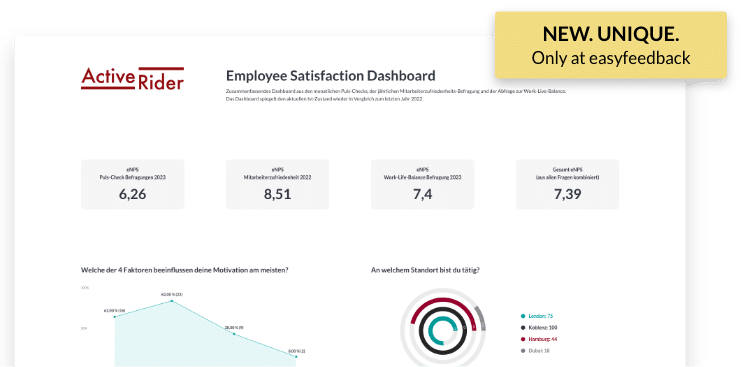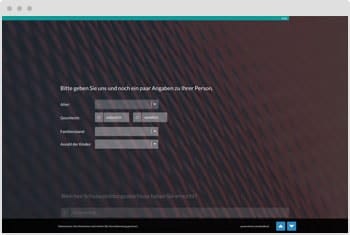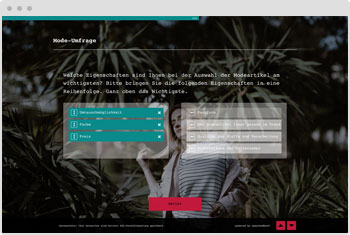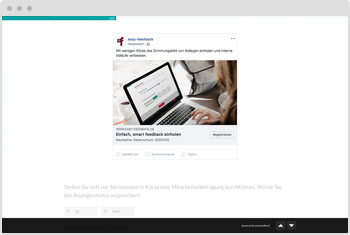Lead marketing strategies and products to success with a target group analysis

With this ready-to-use survey template, you can identify your target group even more precisely, such as private interests in music or events.

“Identifying customer needs is an essential part of our business. easyfeedback accompanies us for many years as a loyal partner in this task. We particularly appreciate the intuitive usability of the survey tool as well as the professional support.”
Guild Lead User Experience Research

“We use easyfeedback for internal and external surveys – fast, comfortable and really easy! Straightforward and cordial support can always create a smile. We really appreciate the permanent development of the platform.”
Guest & Competitor Insights Analyst
Content and targets of this target group analysis template
How well do you already know your customers? The demographic characteristics of your customers are important, but only one component of many. Would you like to know more about the target group? Segment them according to certain characteristics?
With information about their needs, interests, desires, values, and recreational behaviors, you can tailor offers even more appropriately.
Find out with a market research survey where you can address your customers online and offline, whether opera or open-air, and what information is relevant for you. Use the insights gained to realign your marketing strategy and address them in the right place.
Content:
• Online preferences
• Private leisure time activities
• Professional context with preferences
• Customer characteristics
• Different target groups
Targets:
• Conduct analyses
• Define and reach target groups
• Align target group marketing more effectively
• Segment and target customers
• Create personas of typical customers
• Detailed target group definition for innovations
• Attract additional customers

Data privacy protection „made in Germany“ (GDPR)

Anonymity functions for open feedback
Almost everything you need to know about target group analysis
1. What is a target audience?
A target audience is a group of people or companies that are considered to be important market participants. They are grouped by defined criteria such as demographic, socioeconomic or behavioral factors. This is used to develop products tailored to the target group and to address them specifically via various marketing activities in order to persuade them to buy the products or services on offer.
2. Why should I define a target group?
For marketing strategies and products to be successful, companies need to know the needs, wishes and problems of the target audience. It is therefore a good idea to conduct a target group analysis before the market launch, in which you ask about relevant topics such as price sensitivity, consumer and purchasing behavior, or important demographic data.
This information will help you understand the target group in greater depth, identify current trends and changes, communicate the right content and messages via the individual marketing tools, and thus develop products in a solution-oriented manner. Above all, this helps you avoid expensive product developments and marketing activities failing due to irrelevance and leading to financial losses.
3. Where do I get information about my target group?
There are several ways to research and obtain information on the target audience. Below we have listed a few possibilities:
1. Market research and customer surveys
Valuable information can be obtained quickly and easily via targeted surveys, for example, to determine target groups, determine prices or optimize products. With a survey tool such as easyfeedback, this is even possible regardless of country and language.
2. Contact existing customers, dealers and industry experts
Contact current customers personally or ask them to participate in a survey and ask for their interests, problems, opinions and your basis for deciding whether to cooperate or purchase your product.
3. Social media and forums
If you own social media channels, forums or have social listening tools in use, you may also be able to derive information about your target audience from posts, comments and mentions. Just read carefully what prospects and customers write and read between the lines.
4. Web analytics and keyword research tools
You can also use the available data from web analytics and keyword research tools to get an idea of where your website visitors are coming from and what keywords they are using to get to your website. You may discover regional trends and differences or changes in search behavior.
4. What is the best way to proceed with a target group analysis?
If you want to take a closer look at your target group, several steps are necessary.
At the beginning of the target group analysis, it helps to first ask yourself how you would describe yourself as a company and the products you offer. What does your company stand for? What do you offer your customers as a company? What can your offered product do? What is the unique selling point of your product/company? What do customers get out of your product? These and other questions will help you to define your target group in the next step and to identify important criteria and characteristics.
For the definition of the target group, criteria and characteristics should be determined in advance based on demographic and (socio-)economic characteristics such as age, profession, income, company size, industry affiliation, etc. In addition, ask yourself who you want to address and who you do not want to address. Which potential customers fit you as a company and your industry?
Now that you have defined your target group, the description follows. Here, various questions about purchasing, consumption and research behavior will help you. For example, questions such as: How and where does the target group find out about (new) products? What are the reasons for buying products? Where does the target group like to shop? What influences the target group’s purchase decision? What price would the target group be willing to pay for the product?
Once you have described your target group, the next step is to examine the described target group and research its needs and desires. There are various research methods available to you for this purpose. One of the most popular and easiest methods is the (online) questionnaire. Fast, easy, inexpensive and a high coverage makes the questionnaire an attractive method to investigate a target group and get new insights.
Furthermore, there is also the possibility to get to know the target group in more depth via personal or telephone interviews or via workshops and networking events.
Another option is to conduct research via the Internet or in-house, for example by talking to employees from support and sales. These areas of the company are in daily contact with customers and potential prospects and therefore often have important information about customers.
Once you have defined and finally described your target group, the next step is to create one or more fictitious persons, called buyer personas.
Finally, we have summarized the previously described steps of the target group analysis for you once again:
- Company and product reflection
- Define target group
- Describe target group
- Checking the described target group
- Create buyer personas
5. What does market segmentation mean?
Market segmentation is the division of the overall market into specific groups of buyers, which are grouped together by specially defined criteria and characteristics such as buyer behavior, demographic or geographic characteristics.
The purpose of dividing up the market as a whole and forming different groups of buyers is to get to know these different groups of buyers better, to find out about their problems, needs and wishes, and to tailor the approach and marketing activities more effectively to these individual groups of buyers.
6. What is a (buyer) persona and what is its purpose?
A buyer persona is a fictitious person who represents a real person, the target group defined by the company in terms of needs, skills, expectations and behaviors.
While a target group groups several people in terms of commonalities, personas thus reflect a fictitious ideal customer from the target group.
Personas can be created with the help of market research and customer surveys and are a super method for aligning marketing and product development as best as possible with the interests of the target audience.
7. How do I create a (buyer) persona?
Personas are like a profile that describes the profile of an ideal customer of the target group. But to create a profile, you first need to think about what the ideal customer looks like for you and the products you offer.
Once you have defined demographic, socio-economic or behavioral criteria, for example, the next step is to track down the information needed to create the profile.
A possible structure of a buyer persona profile could be as follows:
a. Background on the person
- Name?
- Gender?
- Age?
- Occupation?
- Income?
- etc.
b. Purchasing and consumption behavior
- Problems and challenges?
- Sources for
research for information? - Places of purchase?
- Frequency of purchase?
- Findability?
- Factors for purchase decisions?
- etc.
c. Expectations and goals
- Motivation?
- Goal setting?
- Wishes?
- Expectations of the company?
- Expectations of the product?
- Special functions/services?
- etc.
d. Objections to purchase
- Brand preference?
- Product?
- Service?
- Price?
- Implementation barriers?
- Competitors?
- Prejudices?
- etc.
e. Customer Journey
- Journey path/phases?
- Touchpoints/channels?
- Thoughts and impressions?
- Comparison with competitors?
- etc.
Once characteristics and criteria have been determined, you can next consider how and where to research and track down the information you need. One option, for example, would be to ask for characteristics and criteria of the target group through a targeted survey. Another source could be your own sales staff or customer service, as they are in communication with customers and prospects on a daily basis. Another option would be private conversations/interviews or the use of questionnaires with current customers, dealers or industry experts.
If you have done extensive research and gathered enough information, then you can enter it into the appropriate profile. This is because it is also possible for a company to have different target groups and therefore different desired customers. In this case, you simply create a separate profile for each customer.
You are in professional company







easyfeedback welcomes more than 740.000 participants per month!







